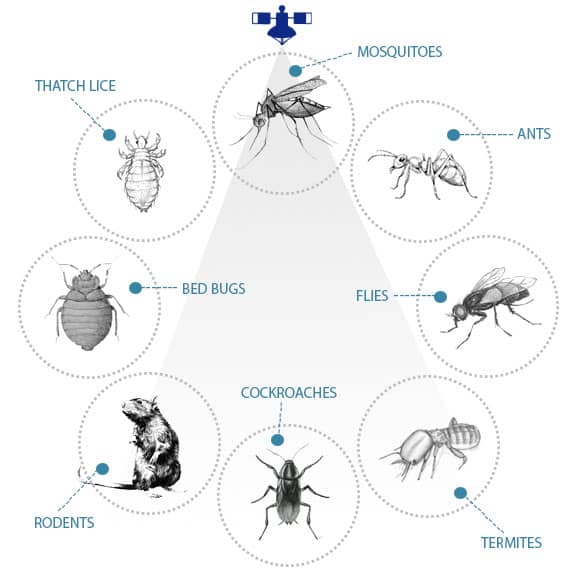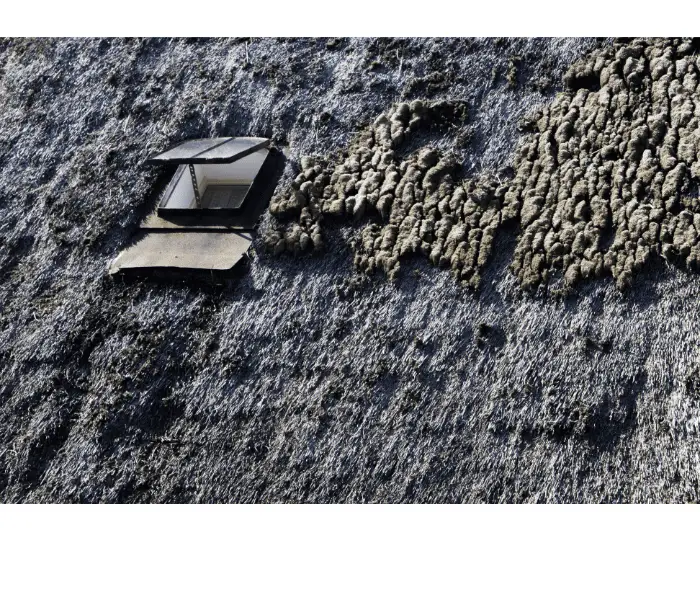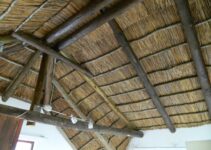The thing about thatched roofs is that, like everything in life, they have their pros and cons.
The benefits of thatched roofs are obvious: They’re beautiful, durable, and last for a very long time. They look traditional, so they fit in with a lot of different styles of architecture, and they don’t require the same upkeep as other roofing materials do.
They’re also more eco-friendly than other materials, since they don’t involve a lot of chemicals during manufacturing. That makes them great for people who want to do their part to help the environment.
One question that comes up a lot is whether these roofs have any kind of roof bugs living in them. So do thatched roofs have bugs? The short answer to this question is yes.
Traditional thatched roofs are made from straw and secured by spars. And straw… well… straw attracts bugs.

While there are modern techniques for reducing bug problems on thatched roofs, traditional straw roofs still have to be cleaned frequently because if you let them go for too long without cleaning them up, the damage could be irreparable.
Common Insects Found In Thatched Roofs
Some insects hide under thatch during the winter months to avoid the cold weather. Others arrive on thatched roofs for warmth or protection from predators like birds.
Often these same insects will try to build nests in the roof.
Here are some of the most common roof bugs found in thatched roofs:
Thatch Spiders
Spiders are perhaps the most common insect found in thatched roofs. They are nocturnal hunters, so they’re only out when it’s dark. Their webs are thick and sticky. They can even trap birds in them! They cause no harm.
Why Do Thatched Roofs Attract Spiders?
Thatched roofs attract spiders because they provide a suitable habitat for these arachnids. Thatched roofs are made of natural materials such as straw, reeds, or grass, which provide an ideal environment for spiders to live and hunt for prey.
The thatching material provides shelter for spiders from the elements, and the small gaps between the thatch strands offer them protection from predators. In addition, thatched roofs often have a warm microclimate that is attractive to spiders, particularly during colder weather.
Thatched spiders also like the roofs because they provide a plentiful food source. Many insects, such as flies and mosquitoes, are also attracted to the warm and sheltered environment of the thatched roof, providing spiders with a bountiful supply of prey.
Overall, while thatched roofs may be a cozy and rustic feature of traditional architecture, they can also serve as an inviting habitat for spiders, making them a common sight in homes with thatched roofs.
Thatch Beetles
Beetles are another common insect found in thatched roofs. Most of the time, these insects eat plants and grasses (often those growing on the roof itself). They will also munch on other dead things found in their environment, like decaying plants or even animal faeces.
Wasps and Bees
Wasps are predators of other insects, which means that they can be found inside a thatch roof looking for prey.
The damage these little guys do is minimal, but if you notice a lot of dead flies around your home or a wasp flying around, it might be time to call an exterminator.
Ants
Ants are attracted to water reeds so many end up living in thatched roofs where they eat bits of insects stuck there as well as any other food sources.
This means these colonies also attract thatch spider lizards since both are preying upon each other.
Cockroaches
Cockroaches are another common thatch pest. Try using this cockroach killer to remove them:
Does Thatch Attract Flies?
Flies have been known to eat the thatched roof itself. They lay their eggs on it and those hatch into larvae that can then feed on the straw as they develop into adults.
Thatched roofs can attract flies for several reasons. Firstly, thatch is made of natural materials like straw or reeds, which can provide an ideal environment for flies to breed and lay their eggs.
The warm and humid conditions created by the thatch can also accelerate the decomposition of any organic matter, providing an attractive food source for flies.
In addition to this, thatched roofs may also have small gaps and openings where flies can enter and find shelter. These gaps can also allow odors from decaying organic matter to escape, attracting flies from a distance.
Do Gnats Live in Thatch?
Thatched roofs can attract gnats due to the natural materials used in their construction. Thatched roofs are typically made from dried plant materials such as straw or reeds. Gnats love these These materials because they create a warm, humid environment.
Gnats are attracted to moist environments and organic matter, such as decaying plant materials. Thatched roofs can provide a perfect breeding ground for gnats if they are not properly maintained. Gnats can lay their eggs in the thatch, and the larvae can feed on the organic material, further attracting adult gnats.
Thatched roofs can be treated with insecticides to deter gnats, but this may not be effective in the long term.
Proper maintenance, including regular cleaning and removal of debris, can also help prevent gnats from infesting thatched roofs.
In general, if you live in an area with a high population of gnats, it may be best to avoid a thatched roof altogether. But let’s dive in to how to properly avoid gnats in your thatch!
How to Avoid Bugs in Thatched Roofs
While it may be impossible to totally avoid thatch bugs, there are some steps you can take to make your roof less attractive. This includes:
Keep Your Roof Clean of Debris
Roof bugs need a place to live, so if they see a dirty roof, they are much less likely to have an infestation in it.
Every couple of months, remove leaves from the eaves troughs to avoid rotting leaves falling onto the roof itself. After strong windstorms when there is a lot of debris and leaves on your roof, use a broom to sweep it all off.

Get Rid of Animal Waste
This is one of the most important steps. Bugs like thatch beetles and flies look for places to lay their eggs, and animal faeces (especially pet faeces) make a great home for these bugs. So get rid of any.
Keep Your Roof Dry
Water is also a great place for bugs to live. Make sure that water drains properly from your roof to avoid puddles. Remove collecting pools of rainwater as soon as possible.
If you do get leaks, patch them immediately. Keeping your roof dry will also help prevent water damage to the house itself as an added benefit.

Getting Rid Of Insects In Thatched Roofs
It should be noted that in order for your buildings and contents insurance to be valid, most insurance companies will insist your thatched roof is regularly maintained and that you can show receipts to prove you have paid for such regular maintenance.
Thatch Roof Pest Control
The inspections and pest control measures must be done often enough but also be of the correct level and quality to maintain the necessary levels of insurance cover.
If you are in any way unsure, you should talk to your broker about the stipulations.
Here are some of the most common ways to control the bugs in thatch:
Wire Netting
Installing a fine-mesh wire netting over the main part of the roof and over the ridge will make it harder for pests to enter the loft space or access or any way damage the roof’s thatch.
Maintain your Roof and Check it Regularly In Between
It’s vital to get a thatcher to regularly check your roof as not everything will be visible to the naked eye.
However, in-between times, check the roof regularly for thatch animals or pests. Signs including holes or straw sticking out may indicate unwanted guests. Sealing any holes or gaps immediately is recommended.
Vacuuming
You could try vacuuming yourself but you’ll be unlikely to get all the critters if you do. There are specialist companies that can use industrial vacuum cleaners along with insecticides to give the place a real blast. This reportedly works a real treat.
Insecticide
While you can buy some of this stuff yourself, it may be a good idea to get an expert in, especially given the amount of chemicals you are likely to need to be using to make any real dent in the insect population in your roof.
Here’s an insecticide I use that is relatively cheap:
Some companies will also have humane approaches to removing honey bees etc.
Thatch Roof Bugs
Roofing thatch commonly houses bugs, so much so that a roof can easily become infested. While some of these critters cause absolutely no harm, knowing which ones to look for and the best ways to get rid of them is important so you don’t have to worry about any serious damage to your home.
To avoid problems in the future, be sure to properly clean and maintain your roof on a regular basis and keep it dry so insects aren’t attracted.
This will also usually be a stipulation to stay on the right side of your household insurance.





